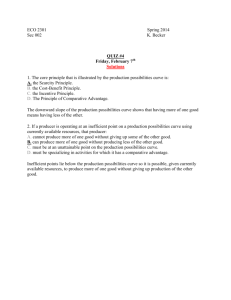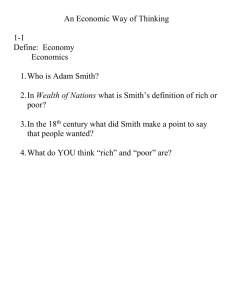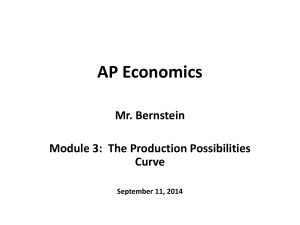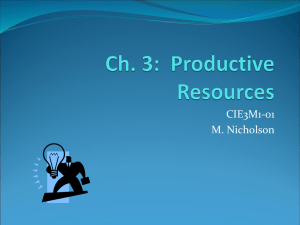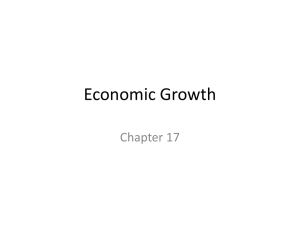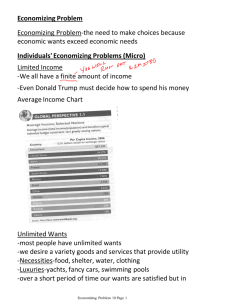test 1 - answers
advertisement
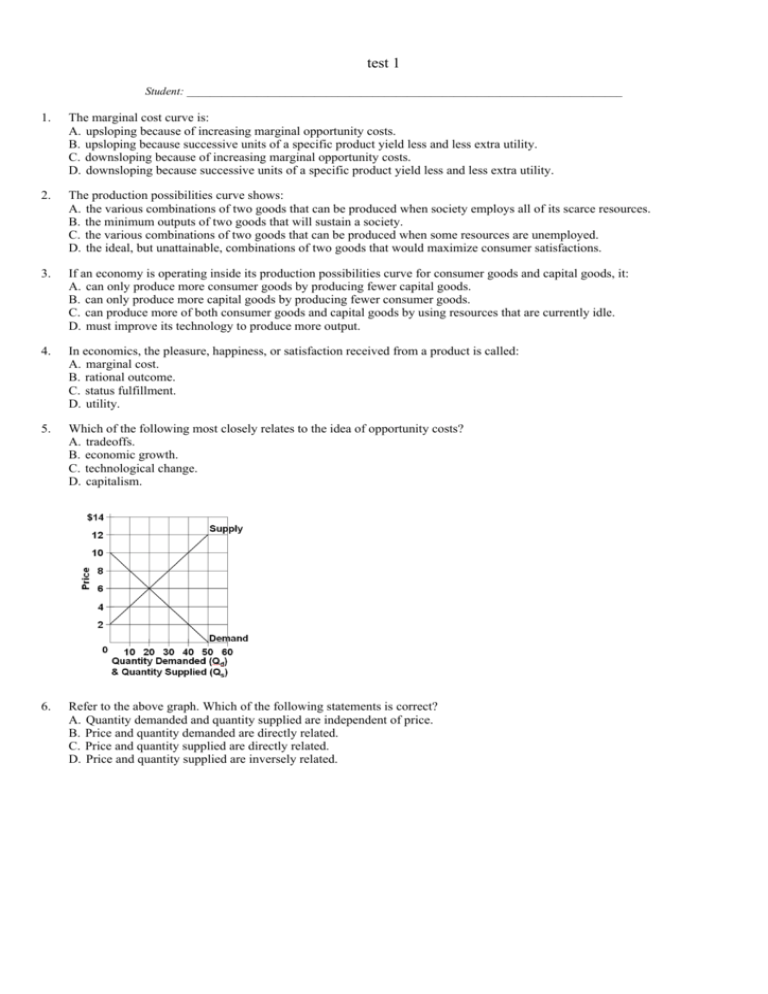
test 1 Student: ___________________________________________________________________________ 1. The marginal cost curve is: A. upsloping because of increasing marginal opportunity costs. B. upsloping because successive units of a specific product yield less and less extra utility. C. downsloping because of increasing marginal opportunity costs. D. downsloping because successive units of a specific product yield less and less extra utility. 2. The production possibilities curve shows: A. the various combinations of two goods that can be produced when society employs all of its scarce resources. B. the minimum outputs of two goods that will sustain a society. C. the various combinations of two goods that can be produced when some resources are unemployed. D. the ideal, but unattainable, combinations of two goods that would maximize consumer satisfactions. 3. If an economy is operating inside its production possibilities curve for consumer goods and capital goods, it: A. can only produce more consumer goods by producing fewer capital goods. B. can only produce more capital goods by producing fewer consumer goods. C. can produce more of both consumer goods and capital goods by using resources that are currently idle. D. must improve its technology to produce more output. 4. In economics, the pleasure, happiness, or satisfaction received from a product is called: A. marginal cost. B. rational outcome. C. status fulfillment. D. utility. 5. Which of the following most closely relates to the idea of opportunity costs? A. tradeoffs. B. economic growth. C. technological change. D. capitalism. 6. Refer to the above graph. Which of the following statements is correct? A. Quantity demanded and quantity supplied are independent of price. B. Price and quantity demanded are directly related. C. Price and quantity supplied are directly related. D. Price and quantity supplied are inversely related. 7. Refer to the above diagram for athletic shoes. If the current output of shoes is Q1, then: A. society would consider additional units of shoes to be more valuable than alternative uses of those resources. B. society would consider additional units of shoes to be less valuable than alternative uses of those resources. C. society would experience a net loss by producing more shoes. D. resources are being allocated efficiently to the production of shoes. 8. Ben says that "An increase in the tax on beer will raise its price." Holly argues that "Taxes should be increased on beer because college students drink too much." We can conclude that: A. Ben's statement is normative, but Holly's is positive. B. Holly's statement is normative, but Ben's is positive. C. Both statements are normative. D. Both statements are positive. 9. Refer to the above diagram. Technological advance that is useful in producing consumer goods but not in producing capital goods is shown by the shift of the production possibilities curve from AB to: A. CD. B. EB. C. AF. D. GH. 10. Economics may best be defined as the: A. interaction between macro and micro considerations. B. social science concerned with how individuals, institutions, and society make optimal choices under conditions of scarcity. C. empirical testing of value judgments through the use of logic. D. use of policy to refute facts and hypotheses. 11. Macroeconomics can best be described as the: A. analysis of how a consumer tries to spend income. B. study of the large aggregates of the economy or the economy as a whole. C. analysis of how firms attempt to maximize their profits. D. study of how supply and demand determine prices in individual markets. 12. A well-tested economic theory is often called: A. an hypothesis. B. a prototype. C. a principle. D. an anomaly. 13. Which of the following would not be classified as an economic resource by economists? A. a professional soccer player B. water in a town's reservoir C. money in a business checking account D. the manager of the local hamburger restaurant 14. Which of the following is associated with macroeconomics? A. an examination of the incomes of Harvard Business School graduates B. an empirical investigation of the general price level and unemployment rates since 1990 C. a study of the trend of pecan prices since the Second World War D. a case study of pricing and production in the textbook industry 15. The alternative combinations of two goods which a consumer can purchase with a given money income is shown by: A. a production possibilities curve. B. a demand curve. C. consumer expenditure line. D. a budget line. 16. Purposeful behavior means that: A. people are selfish in their decision-making. B. people weigh costs and benefits to make decisions. C. people are immune from emotions affecting their decisions. D. decision-makers do not make mistakes when weighing costs and benefits. 17. (Consider This) An exception to the advice "go to college, stay in college, and earn a degree" occurs when: A. tuition expenses are high and rising. B. the opportunity cost of attending college is extraordinarily high. C. the price of textbooks is high and rising. D. the economy is growing rapidly and jobs are plentiful. 18. Which of the following statements is correct? A. The value of the independent variable is determined by the value of the dependent variable. B. The value of the dependent variable is determined by the value of the independent variable. C. The dependent variable designates the "cause" and the independent variable the "effect." D. Dependent variables graph as upsloping lines; independent variables graph as downsloping lines. 19. An increase in money income: A. shifts the consumer's budget line to the right. B. shifts the consumer's budget line to the left. C. increases the slope of the budget line. D. has no effect on the budget line. Answer the question on the basis of the following data: 20. The above data suggest that: A. a policy of tax reduction will increase consumption. B. a policy of tax increases will increase consumption. C. tax changes will have no impact on consumption. D. after-tax income should be lowered to increase consumption. 21. Through specialization and international trade a nation: A. can attain some combination of goods lying outside its production possibilities curve. B. can move from a high consumption-low investment to a high investment-low consumption point on its production possibilities curve. C. will only attain some combination of goods lying within its production possibilities curve. D. will cause its production possibilities curve to shift leftward. 22. Which of the following do economists consider to be capital? A. a pair of stockings B. a construction crane C. a savings account D. a share of IBM stock 23. In moving along a given budget line: A. the prices of both products and money income are assumed to be constant. B. each point on the line will be equally satisfactory to consumers. C. money income varies, but the prices of the two goods are constant. D. the prices of both products are assumed to vary, but money income is constant. 24. A normative statement is one that: A. is based on the law of averages. B. applies only to microeconomics. C. applies only to macroeconomics. D. is based on value judgments. Answer the question on the basis of the following five data sets wherein it is assumed that the variable shown on the left is the independent variable and the one on the right is the dependent variable. Assume in graphing these data that the independent variable is shown on the horizontal axis and the dependent variable on the vertical axis. 25. Refer to the above data sets. The equation for data set 5 is: A. V = .5Y. B. U =-.5V. C. U = V. D. V = 2U. test 1 Key 1. A 2. A 3. C 4. D 5. A 6. C 7. A 8. B 9. C 10. B 11. B 12. C 13. C 14. B 15. D 16. B 17. B 18. B 19. A 20. A 21. A 22. B 23. A 24. D 25. D test 1 Summary Category AACSB: Analytic AACSB: Reflective Thinking Blooms: Level 1 Remember Blooms: Level 2 Understand Blooms: Level 2 Understand Blooms: Level 2 Understand Blooms: Level 2 Understand Blooms: Level 3 Apply Blooms: Level 3 Apply Blooms: Level 4 Analyze Difficulty: 1 Easy Difficulty: 2 Medium Difficulty: 3 Hard Learning Objective: 01-01 Define economics and the features of the economic perspective. Learning Objective: 01-02 Describe the role of economic theory in economics. Learning Objective: 0103 Distinguish microeconomics from macroeconomics and positive economics from normative economics. Learning Objective: 01-04 List the categories of scarce resources and delineate the nature of the economizing problem. Learning Objective: 01-05 Apply production possibilities analysis; increasing opportunity costs; and economic growth. Learning Objective: 01-06 Explain how economic growth and international trade increase consumption possibilities. Learning Objective: 01-07 (Appendix) Understand graphs; curves; and slopes as they relate to economics. McConnell - Chapter 01 Topic: Economics; economic perspective Topic: Graphs and their meaning Topic: Individuals economizing problem -- budget lines Topic: Individuals economizing problem -- budget lines Topic: Individuals economizing problem -- budget lines Topic: Microeconomics and macroeconomics Topic: Positive and normative statements Topic: Production possibilities model Topic: Societys economizing problem Topic: Theories, principles, and models Topic: Unemployment, growth, and the future Type: Graph Type: Table # of Questions 18 7 13 4 1 1 1 1 1 3 13 9 3 5 1 4 5 5 1 4 30 5 4 1 1 1 2 2 4 2 1 2 3 2


